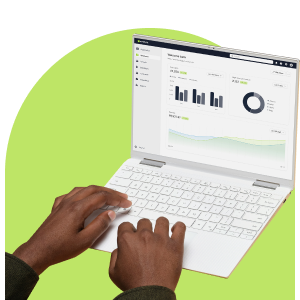‘New year, new goals’ is the slogan on everyone’s lips this January, but after your holiday marketing campaigns, we’re hoping your mantra is more along the lines of ‘new year, new customers’. If this is the case, firstly, we’re giving you a virtual high five, and secondly, we’re unpacking how you can create and execute a new customer welcome email series – and why it’s necessary to do so – with little hassle and while taking care of other parts of your business.
Why Send New Customer Welcome Emails
Now you’ve won customers, you want to keep them engaged and informed about your offerings, and the best way to do this is through communicating with them. A strong new customer welcome email series will help you to do this. It’ll also show your newcomers you care, let them know what they can look forward to, and set the tone of your brand.
Since you have your customers’ names and details, you can personalise your communication too, which will help to show your appreciation for your newcomers from the start of your interaction with them.
If you’re wondering about your capacity to send such emails, don’t panic. We understand how time-consuming it would be to send a string of welcome messages to each of your new customers individually. You’d probably lose track of who you’ve emailed and the timing of the messages, or you’d get distracted by other parts of your business and neglect to send your welcome emails altogether. There is a solution. It’s email automation workflows.
What Email Automation Workflows Are All About
The term sounds complicated – we know – but using email automation workflows will help you communicate effectively and efficiently without much fuss, not only for a new customer welcome email series but any type of communication where you want to send a string of messages automatically.
Recently, we’ve written a few blog posts to break down some of the ways you can use email automation workflows. These include:
- Transform your Email Automation for Lead Nurturing Excellence
- Take the Fuss Out of Onboarding Newbies with Marketing Automation Workflows
- Level Up Your Training Programmes with Email Automation Workflows
So, what are email automation workflows? They are automated communication journeys you can customise and set up with certain conditions, which determine how and when your subscribers receive messages.
For a new customer welcome email series, you would build a workflow to create and send customised messages to your latest subscribers and select the timing of these messages according to the conditions you choose.
We’ll detail each step of this process for a new customer welcome email series in the following section, but first it’s important to note you need a platform – like Everlytic – fitted with software to build and execute email automation workflows. Techniques on different platforms may vary, but to give you an idea, below we demonstrate how to create a workflow on Everlytic.
Steps to Build a Workflow for New Customers
Step one in building your new customer welcome email workflow is to enter the basic properties – some of which will be visible to you only and some, like the ‘From Name’ and ‘From Email’, will be what your subscribers see in their inboxes.
Step two is to create the workflow. This is where it can get a little detailed, as it depends on how you want your new customers to enter your workflow. You can set up the workflow to trigger after a single event. This is likely what you’d use for new customers. Examples include when a customer subscribes to your new customer contact list – like via a subscription form – or when they make a purchase from your e-commerce store.
Once you have selected which type of workflow you want to set in motion, you can add additional criteria to filter contacts, which enables you to be specific about how and when a customer will receive each message in your chain of communication.
Then, you’d take step three, which is to select the list of contacts to whom you want to send your workflow, and you can segment this list with filters too.
However, for step two, it is also possible to select up to five different ways for your new customers to be added to a specific workflow, depending on whether they take certain actions to trigger the workflow to begin. Examples include when someone clicks a link on a landing page, clicks a link in an email, or opens an email.
In this case, you can also use multiple filters to add criteria for your contacts to meet before receiving certain emails in your workflow, and you can add delays, actions, and conditions throughout your workflow.
The next step is to select the specific days and times you want the messages in your workflow to be sent. This will allow for your messages to be sent while you take care of other parts of your business.
Then, confirm all the settings for your workflow, and voila, it’s ready to be launched.
Want to discover how to improve your email engagement? In this blog post, we take a deep dive into three types of metrics you need to measure the performance of your bulk email campaigns quickly and effectively.
An Example of a New Customer Welcome Email Workflow
If it’s a little difficult to picture how the workflow would run, we’ve got you covered. In this section, we’re giving you an example of a new customer welcome email workflow that entails a subscription event – like when someone buys a product or service from your online store.
First, you could send your new customer an email thanking them for their purchase and welcoming them.
After three days, you could send them a second email detailing more about your brand and you could tell them how often they can expect to receive emails from you. You could also share some helpful advice or tips to show your brand provides value and doesn’t only push products or services. It’s also a good idea to ask your new customer to follow you on social media to get them to engage more with your brand.
You would then wait a further three days and set a condition for whether the second email was opened. If it was opened, you could send another email showcasing more products or services and give them a discount code to entice them to become a returning customer.
If the second email was not opened, you’d re-send it, wait three days and then send your third marketing email in the series.
The findings of our latest Email Marketing Benchmarks Report led our team to tell industry professionals email is still a serious medium with huge growth potential. Read our blog post to discover all the details.
Turn First-Time Customers into Long-Term Clients
A new customer welcome email series is important in fostering a long-standing relationship with those that make their first purchase from your business. This is because, when done well, these emails can break the ice, serve to showcase what your brand stands for, inject your brand personality into your customer relations, and add value by providing tips or advice.
Sending a few emails after your customer has made their first purchase will also encourage them to keep your brand top of mind and hopefully engage with your brand via your email, social media, and website.
Ultimately your engaging welcome messaging will build trust and entice a first-time customer to become a returning client.
Create Hassle-Free Welcome Emails Efficiently
First impressions last, which is why creating an effective new customer welcome email series can go a long way in fostering strong relationships with newbies and keep them as returning clients. Using email automation workflows will help you streamline your communication, enabling you to send engaging and personalised welcome emails to each new customer automatically without lifting a finger.
Automate Your Welcome Emails Today
The key to building an effective new customer welcome email series is having the software to create a workflow so you can send engaging, personalised, and relation-building messages automatically while taking care of other parts of your business. This is why you need a platform like Everlytic.



